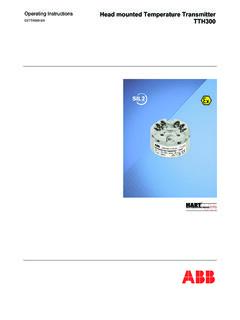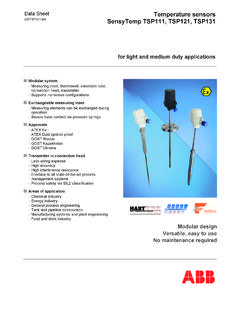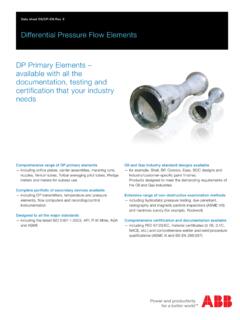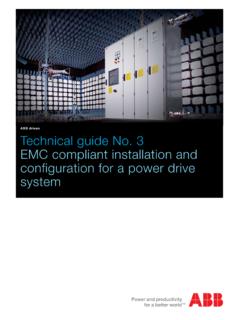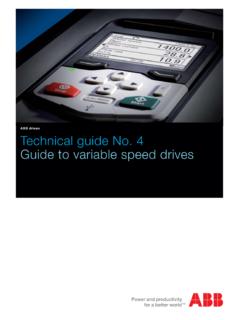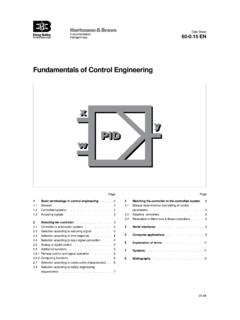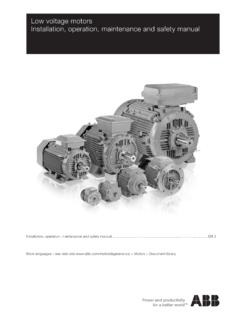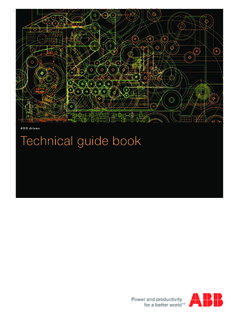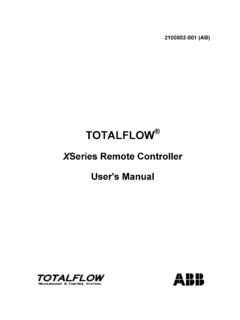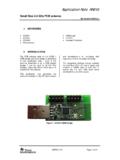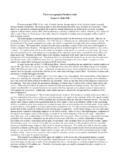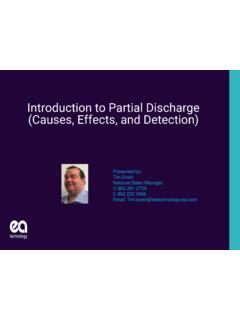Transcription of ABB DRIVES Technical guide No. 6 Guide to harmonics with ...
1 ABB DRIVES Technical Guide No. 6 Guide to harmonics with AC DRIVES Guide to harmonicsThis Guide is part of ABB s Technical Guide series, describing harmonic distortion, its sources and effects, and also distortion calculation and evaluation. Special attention has been given to the methods for reducing harmonics with AC Guide NO. 6 Guide TO harmonics WITH AC DRIVES2 Table of contents004 Basics of the harmonics007 Standards for harmonic limits011 Evaluating harmonics012 How to reduce harmonics020 Other methods for harmonics reduction023 Summary of harmonics reduction025 Appendix029 Definitions3 Harmonic currents are created by non-linear loads connected to the power distribution system.
2 Harmonic distortion is a form of pollution in the electric plant that can cause problems if the voltage distribution caused by harmonic currents increases above certain limits. All power electronic converters used in different types of electronic systems can increase harmonic disturbances by injecting harmonic currents directly into the distortion sources and effectsCommon non-linear loads include motor starters, variable speed DRIVES , computers and other electronic devices, electronic lighting, welding supplies and uninterrupted power effects of harmonics can include overheating of transformers, cables, motors, generators and capacitors connected to the same power supply with the devices generating the harmonics .
3 Electronic displays and lighting may flicker, circuit breakers may trip, computers may fail and metering may give false the cause of the above mentioned symptoms is not known, then there is cause to investigate the harmonic distortion of the electricity distribution at the plant. The effects are likely to show up in the customer s plant before they show on the utility Technical Guide has been published to help customers to understand the possible harmonic problems and make sure the harmonic distortion levels are not currentsIn an ideal case the current in an AC grid is a pure sine wave and does not contain harmonics .
4 In reality the current deviates from this pure sine wave and contains harmonics . Basics of the harmonics Figure A pure sinusoidal voltage and current does not contain any harmonics . Figure Voltage and current that deviate from the sine form contain Guide NO. 6 Guide TO harmonics WITH AC DRIVES4 All continuous periodic signals can be presented as a sum of sinusoidal components: Fundamental + 3rd + 5th + 7th + ..The harmonic current frequencies of a 6-pulse three phase rectifier are n times the fundamental frequency (50 or 60 Hz). On a 50 Hz network a 150 Hz (3 x 50 Hz) waveform is the 3rd harmonic, a 250 Hz (5 x 50 Hz) waveform is the 5th harmonic, a 350 Hz (7 x 50 Hz) is the 7th harmonic and so principle of how the harmonic components are added to the fundamental current is shown in figure , where only the 5th harmonic is shown.
5 Usually harmonics are calculated up to the 40th or 50th order. Figure The total current as the sum of the fundamental and 5th harmonic. Fundamental signal = sin(x) Periodic signal (x) = Fundamental + 5th = sin(x) + (5x) 5th harmonic = (5x)5 The amount of harmonic distortion is expressed as a THDI% value:where I1 is the rms value of the fundamental frequency current and In is the nth harmonic components are as shown in Figure Figure The harmonic content in a current of a 6-pulse rectifier (with choke). Order of harmonic componentHarmonic current % Technical Guide NO. 6 Guide TO harmonics WITH AC DRIVES6 Limits for harmonic currents are given in several national and international standards.
6 Additionally, many transmission and distribution system operators have issued requirements especially for high power equipment connected directly to medium or high power grids. Certain industries have even set factory-specific regulations. The most important standards are the ones issued by International Electrotechnical Commission (IEC).These are important especially within the countries of the European Economic Area (EEA) that have agreed on common minimum regulatory requirements in order to ensure the free movement of products within the EEA. The CE marking indicates that the product works in conformity with the directives that are valid for the product.
7 The corresponding European standards specify the requirements that must be met. In general the European EN standards are the same as the IEC ones, only the prefix IEC is replaced by important publisher is the Institute of Electrical and Electronics Engineers (IEEE) located in the USA. IEEE standards are often required outside the USA as well. The most common international and national standards that set limits on harmonics are described shortly in the 61800-3 (IEC 61800-3) Adjustable speed electrical power drive systemsPart 3: EMC requirements and specific test methodsIEC 61800-3 is the product standard for DRIVES that defines requirements for electromagnetic compatibility (EMC).
8 Regarding harmonics in a low voltage (230/400 V, 50 Hz) public supply network, the limits and requirements of IEC 61000-3-2 apply for equipment with a rated current of 16 A. For equipment with a rated current greater than 16 A but less than 75 A standard IEC 61000-3-12 applies. Note that when one or more power drive systems (PDS) are included in equipment the standards apply to the complete equipment, not the PDS alone. Thus if the equipment contains linear loads such as heating resistors in addition to PDS, higher harmonic emissions from PDS are allowed for equipment in the scope of IEC 61000-3-12 as the rated current of the equipment is higher than the rated current of the PDS alone.
9 For professional equipment in the scope of IEC 61000-3-2 no limits are specified if the total rated power is greater than 1 equipment not in the scope of IEC 61000-3-2 or IEC 61000-3-12 standards, the IEC 61800-3 states that the manufacturer shall provide in the documentation of the PDS, or on request, the current harmonic level THC, under rated conditions, as a percentage of the rated RMS current on the power port. The harmonic currents and the corresponding THC shall be calculated for each order up to the 40th. For these standard calculations, the PDS shall be assumed to be connected to a point of coupling (PC) with a short circuit ratio of RSC = 250 and with initial voltage distortion less than 1%.
10 The internal impedance of the network shall be assumed to be pure reactance. If a PDS is used in an industrial installation, a reasonable economical approach, which considers the total installation, should be applied. This approach is based on the agreed power, which the supply can deliver at any time. The method for calculating the harmonics of the total installation is agreed Standards for harmonic limits7and the limits for either the voltage distortion or the total harmonic current emission are agreed on. The compatibility limits given in IEC 61000-2-4 may be used as the limits for voltage 61000-2-2, electromagnetic compatibility (EMC) Part 2-2: Environment - Compatibility levels for low frequency conducted disturbances and signalling in public low voltage power supply systemsThis standard sets the compatibility limits for low frequency conducted disturbances and signalling in public low voltage power supply systems.
